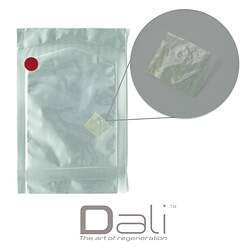The Amnion Chorion membrane is an ideal barrier membrane for many dental applications. The DALI ™ amnion chorion membrane, is a dehydrated amniotic membrane allograft that is shelf-stable and minimally manipulated to maximize the benefits of the amniotic membrane. If you have any questions about the Amnion Chorion membrane, please review our FAQ below.
What suturing techniques and suture material is recommended for use with amnion-chorion membranes?
There are many different suturing techniques and we cannot recommend one over the other. However, in socket preservation procedures, it seems as if many clinicians seem to prefer a reverse figure eight type of suture technique. The reverse technique refers to the movement of the suture needle from inside the socket to the outside. This aids in membrane retention. In terms of suture material, PTFE Suture (3.0 or 4.0) is mostly used due to the monofilament nature, which eliminates bacterial wicking. However, PTFE sutures are non-resorbable. PGCL Sutures are an absorbable monofilament suture that could also be used as alternative to PTFE. What is the difference between this amnion-chorion membrane and others that are on the market?
There are now several amnion-chorion membranes that are marketed in dentistry and that are each processed by highly-respected and regulated US-based Tissue Banks. In general, although there are slight differences in processing, all the amnion-chorion membranes are processed in a substantially similar manner, as they must be minimally manipulated according to FDA guidelines. Briefly, the membranes are deepithelialized (outermost amnion layer is removed), and the remaining amnion/chorion is dehydrated, cleansed/rinsed, sterilized and packaged. Apparently, the main difference between some of the membranes is what layers are removed during processing (i.e. there are several underlying layers in both amnion and chorion). Some processors remove the "spongy" layer from the amnion, while others retain it (keeping it more minimally manipulated). Other processors claim to have a "thicker" membrane due to the inclusion of the Trophoblast layer part of the Chorion (the trophoblast is the innermost layer of the Chorion and the least exposed to maternal fluids). We are not aware of any studies that compare the clinical results from the various membranes, and there is no clinical evidence whatsoever of the superiority of one brand of membrane over any other. As mentioned, all the membranes are minimally processed according to strict FDA and AATB guidelines, and all are equally effective when used with proper protocols.In terms of this amnion-chorion membrane, it is processed by Surgenex, an industry-leading allograft provider setting the standard in tissue quality and safety. The membrane is deepithelialized, as noted above. Deepithelialized mainly refers to the outermost amnion layer that is exposed to maternal fluids, and is generally the most impacted with blood clots. In the process of removing the blood clots from the membrane, the Epithelium layer dis-attaches, thereby exposing the Basement membrane of the amnion (the first layer of collagen). Regarding the Trophoblast layer, the layer is left intact during the processing of the membranes. Additional, the tissue bank does not separate the amnion and chorion layers during processing, preserving the spongy layer, and just cleanses the tissue in order to maintain as much of the native tissue as possible. Separation of layers during processing is thought to adversely impact retention of the native growth factors. What is the resorption time for amnion-chorion membranes?
Amnion-chorion membranes generally resorb in 8 to 12 weeks. If the membranes are left exposed, this absorption profile will obviously differ, but given the many factors that could impact an exposed membrane, it is not possible to give a precise resorption profile for an exposed membrane. However, amnion-chorion membranes have proven to behave exceptionally well even under exposure. Which side of the amnion-chorion membrane is placed up and which down? Is there an orientation?
No there is no orientation. This particular amnion-chorion membrane, as well as all others we have seen in dentistry, do NOT have any orientation, as they are deepithelialized. They can be placed up or down, folded, and/or layered, without any concern. What are some post-operative guidelines for amnion-chorion membranes?
If the membrane is exposed to the oral environment, then for 3 days post-op please instruction the patient to avoid overly aggressive rinsing, swishing with any solution to avoid dislodgement of the membrane. After 3 days, gentle rinsing with tap water is recommended for the next 7 days. The patient should not use any oral rinses 10 days post-op. This includes antiseptics; chlorhexidine (Peridex®), chlorhexidine without alcohol, and other common oral rinses. Oral rinses are can adversely impact the health of gingival cells, and chlorhexidine specifically may adversely impact the membrane. After one week the patient may begin using an oral rinse for plaque control. After 10 days post-operatively, the patient may begin using an oral rinse for plaque control.
